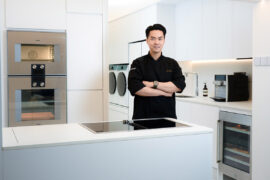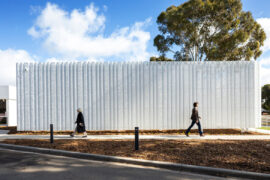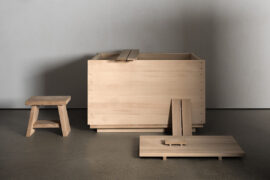As breakthroughs in medical science transform the future of patient care, so too does architecture, writes Tara Veldman of BLP.

Hong Kong Children's Hospital, photography courtesy of BLP.
July 18th, 2022
As breakthroughs in medical science are transforming the future of patient care, so too is architecture. Using what Billard Leece Partnership (BLP) has coined ‘translational design’, our multi-disciplinary teams of architects and researchers work in close collaboration with clinicians and patients, reimagining hospitals through art, nature, community, and place.
Grounds include edible gardens, kitchens are designed so families can cook together, and rooms also accommodate parents who want to stay with their kids. It’s an award winning, holistic approach that is having a positive impact on patient wellbeing.
“To reframe what a hospital space is and should be,” says Dr Rebecca McLaughlan, a healthcare environments researcher at the University of Sydney, “is all about putting things into the atmosphere that kids aren’t expecting to see, so their focus can shift away from their illness to things that seem far more exciting.”

Over the past decade the study of specialist healthcare has brought together the knowledge and design intuition of architects with evidence-based research and consultation with patients and clinicians that goes directly to their needs now and into the future.
It’s a methodology BLP has coined ‘translational design’ and it underpins our practice’s multi-disciplinary studios in Sydney, Melbourne, and Hong Kong; with state-of-the-art healthcare facilities completed in Hong Kong, Perth and Melbourne; two tertiary paediatric hospitals currently underway in Sydney – The Children’s Hospital, Westmead, and the Sydney Children’s Hospital and Minderoo Children’s Comprehensive Cancer Clinic, Randwick; and a recently completed dedicated paediatric unit in the new Campbelltown Hospital.
Experience demonstrates that a project’s success centres on articulating spaces by translating evidence and feedback from patients and staff. It’s a complex balance that when everything works creates spatial empowerment and empathy, and interiors that engage with art and nature, that are bright and flexible and promote collective wellbeing with warm, natural materials, subtly integrated medical equipment, and finishes that are light-years away from grey vinyl floors, white walls, and institutional furniture. They feel less clinical, are calm and welcoming and, importantly, blur the line between hospital and home.

‘Positive distraction’ and ‘atmospheric inclusiveness’ contribute to wellbeing, particularly when the imagination of kids is ignited. For kids, play is not a singular destination, rather a way of life, so our approach is to design spaces from the viewpoint of children and adolescents where play and therapy are intertwined, and exploration and fun are part of the healing process.
BLP’s strength in translating evidence-based research from multiple stakeholders into the physical environment has produced holistic places of healing, where the recovery process is intrinsically linked to minimising stress, anxiety and pain, and providing a ‘home away from home’. Our team includes trained nurses and health planners who assist designers to create architecture that supports both the clinical and the personal experience integral to unpacking the complexity of the modern hospital, and the pathways to healing for the patient and their families.
At the Children’s Hospital in Perth, colour, shape and scale de-stigmatise the clinical spaces making them fun, inclusive, and engaging. Rooms have lowered window seats and visual treats at eye level, while seating areas are not just for sitting, but for climbing, hiding, and exploring and rooms allow for siblings or friends to undertake care together.
In Hong Kong, the research team recognised that cooking was a very important part of family life, so kitchen spaces were integrated to allow parents and grandparents to bring in food and prepare a meal for their children. While art took the form of a puzzle and the adventure for kids is to find all the pieces that are scattered throughout the building.

For the award-winning design of Melbourne’s Royal Children’s Hospital, BLP drew inspiration from architect Alvar Aalto’s ‘transparent’ Helsinki House and its connection to nature, spending time documenting the adjoining Royal Park and the atmosphere of the native bush.
Most rooms have park views, and all windows have glass sunshades that allow activity in the grounds below to be viewed from the patient’s bed. Further research drew on the educational theory of Reggio Emilia and the importance of sparking a child’s curiosity.
Here, distractions include a two-storey coral reef aquarium, a meerkat enclosure, and an installation by artist Alex Knox that allow kids at different ages to get absorbed. To understand the impact, a research team from the University of Melbourne obtained the views of 250 patients who described the colours and brightness of spaces as creating “a happy, warmer, welcoming environment” where kids feel safe (McLaughlan and Willis, 2022).

Our design of The Children’s Hospital, Westmead and Sydney Children’s Hospital Stage One and the Minderoo Children’s Comprehensive Cancer Centre, was co-created with clinicians, researchers, patients, children, families, and carers, in a fast, collaborative, and specialised approach designing for individualised care.
BLP approached each project with both creative and technical expertise, designing with head and heart to shape a purpose-built, playful, and supportive environment for children and their families. Key features of Sydney Children’s Hospital, Randwick, include the ‘backyard’ as a nature-filled social space for gathering with family and pets, dropping into the café, or watching an outdoor movie.
With families and research staff often on-site 24/7, the precinct will have extended hours to match, transforming the experience throughout the day and evening. While the second stage of The Children’s Hospital at Westmead engages biophilic design principles to create an environment for patients, with natural light, physical and visual connection to green spaces, as well as key learnings from other projects.
There is the integration of a communal kitchen for families, a welcoming green park at the front door and vibrantly coloured walkways and ramps to lead families into the heart of the hospital. In contrast, the new Campbelltown Hospital, uses extensive artwork co-created by the community and First Nations people to distract and uplift all those that visit, work, and stay there. Continuous light filled spaces work in harmony with detailed botanical graphics of local medicinal plants promoting wellbeing, healing, connection to the natural environment, at the same time offering respite for kids, patients, families, and staff.

Inside the development of every project, the BLP team’s design process is highly collaborative. Vision workshops during the intensive concept design stage are key to understanding the issues and aspirations from the perspective of the client, including the stakeholders, clinicians, and patients, and central to the human-centred approach that underpins BLP’s translational design methodology.
By fostering this crucial collaboration between design, research, and evidence, we can navigate the stumbling blocks to innovation to create a dynamic and open design process, and, most importantly, projects where the outcome matches the intent.
Billard Leece Partnership (BLP)
blp.com.au



We think you might like this article about Sydney Children’s Hospital by BLP.
INDESIGN is on instagram
Follow @indesignlive
A searchable and comprehensive guide for specifying leading products and their suppliers
Keep up to date with the latest and greatest from our industry BFF's!

Now cooking and entertaining from his minimalist home kitchen designed around Gaggenau’s refined performance, Chef Wu brings professional craft into a calm and well-composed setting.

In an industry where design intent is often diluted by value management and procurement pressures, Klaro Industrial Design positions manufacturing as a creative ally – allowing commercial interior designers to deliver unique pieces aligned to the project’s original vision.

Merging two hotel identities in one landmark development, Hotel Indigo and Holiday Inn Little Collins capture the spirit of Melbourne through Buchan’s narrative-driven design – elevated by GROHE’s signature craftsmanship.

At the Munarra Centre for Regional Excellence on Yorta Yorta Country in Victoria, ARM Architecture and Milliken use PrintWorks™ technology to translate First Nations narratives into a layered, community-led floorscape.

BLP’s new Sydney Children’s Hospital, Randwick building brings together paediatric care, family-centred design and Australia’s first Children’s Comprehensive Cancer Centre in a major addition to the Randwick Health & Innovation Precinct.

Through expert architecture, EBD Architects has provided a human face to great design and created a project that enhances the lives of people and community.
The internet never sleeps! Here's the stuff you might have missed

Jason Gibney, winner of the Editor’s Choice Award in 2025 Habitus House of the Year, reflects on how bathroom rituals might just be reshaping Australian design.

Designed by Foolscap, the debut Melbourne store for Song for the Mute translates sound and rhythm into an immersive retail experience that feels closer to a listening room than a shopfront.